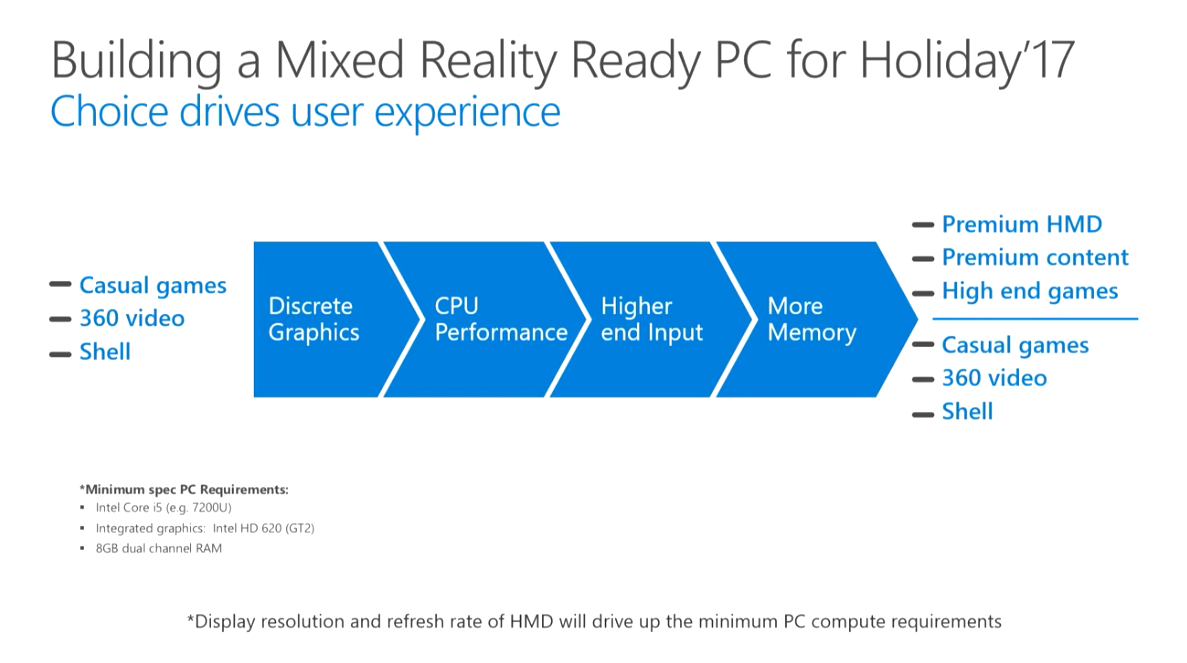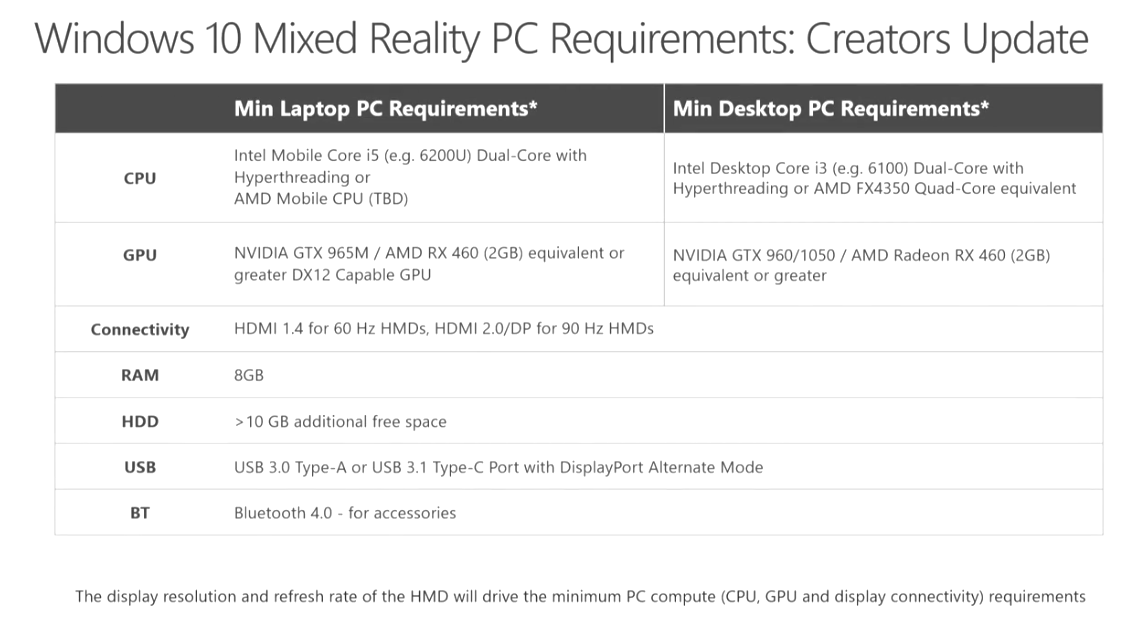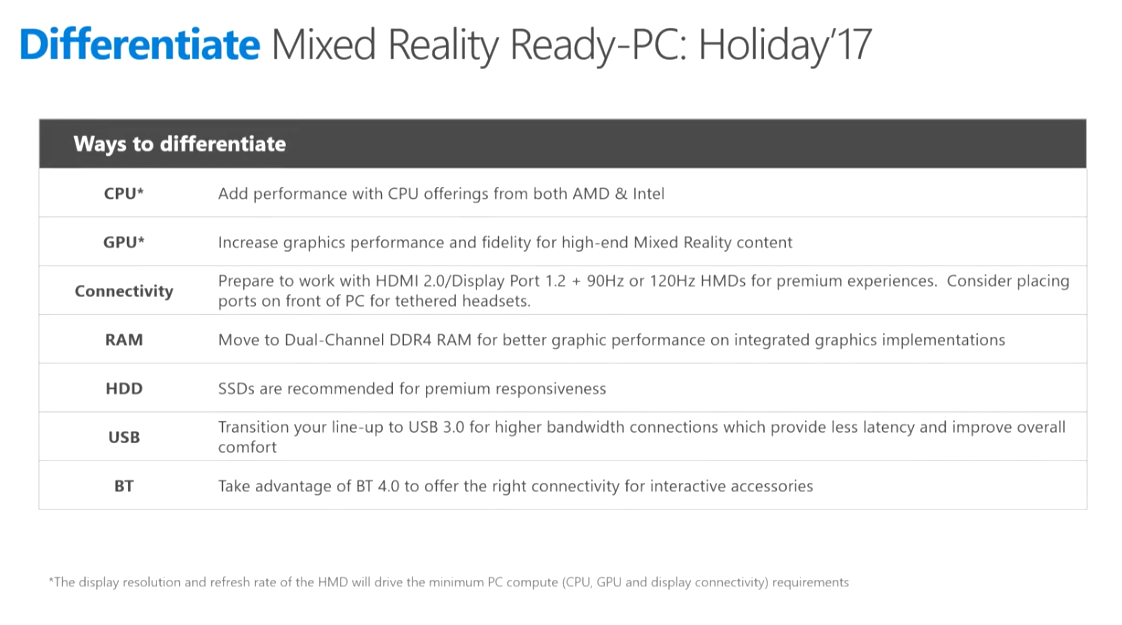The PC Requirements For Mainstream VR HMDs
In the same presentation where Microsoft discussed the range of specifications for the upcoming wave of mainstream PC-tethered VR HMDs, we got more details about the requirements for the PCs that will power them.
Although we recently learned about the minimum PC specifications at an earlier WinHEC announcement, Microsoft’s session revealed quite a bit more.
A Range Of Specs For A Range Of Applications
It’s funny, but it seems that there are things we instinctively know to be true about PCs that we don’t think about in the XR world. One of the most obvious is the notion that XR users will have a wide variety of needs and use cases, and therefore, there will be a commensurate array of PCs and HMDs to accommodate.
This is the same reason why some people need high-end gaming desktops, some are happy with a $200 Chromebook, and everyone else is everywhere in between. Higher-end PCs cost more and can do more; the same is true of HMDs.
And so, just as Microsoft and Intel have developed a range of specifications for the HMDs, they’ve developed a range of specifications for the PCs that will power them, as well. As we mentioned in an earlier article: “HMDs [...] will be used to do all sorts of different computing tasks, from casual computing (such as web browsing) to communications (Skype) to serious productivity (Excel and PowerPoint floating in front of you) to passive entertainment (watching movies) to active entertainment (such as gaming).
Understanding PC Requirements: A Second Axis
The minimum and recommended specifications for the range of XR HMDs are actually not quite straightforward. To really understand it all, you have to think in two dimensions--on both X and Y axes, if you will. We’re looking at what a range of PC hardware can support, but also what a range of HMD hardware demands.
If you wanted to, for example, play a certain game at a certain resolution, you would need to look at just one axis (let’s say the X axis): Weaker PC hardware means you can get less out of the game, whereas high-end PC hardware will deliver an optimal experience.
Get Tom's Hardware's best news and in-depth reviews, straight to your inbox.
With these HMDs, you still have that same X axis; as we’ve discussed, people will be using their PC-connected HMDs for tasks as tame as light web browsing, but also applications as intense as AAA gaming. Therefore, weaker PC hardware is still at the far left of the X axis, and the more powerful PC hardware is on the far right.
However, you can think of the range of HMD hardware as a Y axis. At the very bottom of the Y axis, you’ll have a bare-essentials HMD; at the very top, you’ll get an HMD with the most, and best, features.
Therefore, when you think about PC requirements, you have to consider what applications and HMDs will demand.
If you squint, you can see the X/Y axis present in this slide:
On the far left, the XR experiences are pretty tame: You can use Universal Windows Apps within the Holographic shell (which could potentially be fairly amazing, if the experience is strong enough), play casual games, and view 360-degree images and video. That’s about on par with what you get from a Gear VR-level HMD (with the exception of the apps-in-the-shell business).
On the far right, though, is where the Y axis comes into play. Starting from the left, Microsoft suggests that you get more bang for your PC hardware buck by adding discrete graphics, a better CPU, more memory, and “higher-end input”--all of which is obvious. According to the slide, at the high end (all the way to the right), you’ll also get to play higher-end games and enjoy “premium content.” But also note that “Premium HMD” is listed there, too.
What Microsoft is trying to say is that in order to get all the best stuff, you need robust PC hardware and one of the highest-end VR HMDs. Remember, those HMDs are going to come with a wide range of specifications.
Your task as a consumer will be to balance the capabilities of your PC with those of your HMD. For example, don’t expect to get superb VR performance out of your beastly gaming PC with an entry-level $300 VR HMD, nor with your Ultrabook and one of the best VR HMDs.
PC Requirements: Is There A Time Warp?
Here’s a key slide, but even this one isn’t quite as clear as we’d like (we’ll explain in a moment):
This slide lists the minimum PC requirements for both laptops and desktops. We’ve seen the former before, but not the latter. Note that the requirements are identical, save for the CPU--which mainly has to do with form factor (e.g., an Ultrabook-class chip goes in an Ultrabook, not a desktop). But, hey, apparently we’ll be able to get away with running VR off of a Core i3 (Skylake or Kaby Lake) or an AMD FX4350.
But there’s a wrinkle: These are specs that will run this gear as of “Holiday ‘17.” An adjacent slide shows different specs--primarily around the graphics. Gone is the integrated graphics minimum spec; this one says you’ll need a discrete GPU--a GTX 965M (GTX 960 on the desktop) or AMD RX 460 or equivalent. That means Ultrabooks won’t be able to offer what Microsoft considers an XR experience once the Windows 10 Creators Update lands.
Thought of one way, that’s perhaps disappointing given what we were previously told about the minimum PC requirements; but the Creators Update seems like a big deal, so it follows that perhaps the new capabilities demand better hardware.
Except...the Creators Update is scheduled to land in the spring of 2017. That’s many months before the “holidays” of 2017, but the “holiday ‘17” minimum specs are lower than those required by the Creators Update.
To be honest, we do not know what Microsoft is thinking here. Our assumption is that there will perhaps be further stratification based on the operating system: Windows 10 minimum specs and Windows 10 Creators Update minimum specs.
That’s a lot of juggling--you have to balance the PC hardware with the HMD hardware with the version of Windows 10 that you’re running. (Don’t worry folks; we on the Tom’s Hardware editorial team as well as our wonderful forum members will be here to help you sort these things out when the time comes.)
It’s also possible that, in part, the Creators Update specs are mainly intended as guidance for OEMs who are planning to show off these XR capabilities on their systems. The WinHEC crowd consists of a lot of companies that make things--less so developers (which is what events like IDF and Build are for), and even less so journalists--so Microsoft may just have provided those specs to help ensure that OEMs are using sufficient PC hardware to show off their HMDs.
There’s a final bit that Microsoft shared, concerning ways that OEMs can differentiate their PCs for various XR experiences:
Note that the “move to” dual-channel DDR4 RAM is advisable, which means that the minimum specs require just DDR3. Unsurprisingly, SSDs over HDDs are preferable, and it seems that there are plans for Bluetooth “interactive” accessories. That could mean 3DoF or 6DoF hand controllers.
It’s refreshing to finally get some answers from Microsoft and Intel about mainstream HMDs and PC requirements for them, but even so, there’s much we do not yet know--and I believe that’s because no one yet knows exactly what the market will look like, what people will actually want and use, who will make what, and what it will all cost.
However, make no mistake: If two of the most important personal computing companies in the world believe that XR is the future, it will be, one way or another. And you, the consumer, will help shape it.
Seth Colaner previously served as News Director at Tom's Hardware. He covered technology news, focusing on keyboards, virtual reality, and wearables.
-
excalibur1814 Basically, once you skip all the blah blah, etc, etc and yadda yadda, get onto ebay and buy a second hand quad core i5, no matter what it is, any Samsung SSD of reasonable size, then buy a specified graphics card of worth.Reply
-Save cash
-More than fast enough
-Ready to go
Then you can buy the over priced VR headset that'll eventually be worth $50 in less than a year. Welcome to 'please buy our stuff over and over again' 101.
P.s. There is next to ZERO need to buy a NEW computer. -
InvalidError Reply
As long as you already own a decently powerful one.19026231 said:P.s. There is next to ZERO need to buy a NEW computer.
I'm surprised that DDR3 vs DDR4 even got mentioned as there is nearly no performance benefit to DDR4, certainly none worth buying a new PC specifically for, even less so when dealing with i3-class CPUs.
-
wiak the intel in the minimum made me laught, nobody in their right mind would run VR on intel graphicsReply
for what i call minimum i would do
RX 460 2GB/GTX 1050 2GB
and for premium
RX 470 4GB/1060 3GB or better
anything else is stupid -
shane_50 Exciting times ahead in the virtual world in next few years and with xr leading the way . I love the tech umbrella term putting all realities under the one term creates less confusion and xr sets the trend for the future.Reply -
TEAMSWITCHER Let me translate this article for everyone. VR specs are getting convoluted because people are not going to go back to clunky, loud, space consuming, desktop PC's to tinker with Virtual Reality. People want Ultrabooks! VR is dead-on-arrival until Intel makes ultra-low powered processors with RX 480 equivalent Intel Integrated Graphics.Reply -
anbello262 You are all asking for 480 level graphics. I believe that you have missed the point of this article. It clearly states that this is NOT for premium gaming. That's only a little part of the spectrum. You can use XR skype/excel with A LOT less than a 480. Intel integrated graphics is MORE than enough for most applications.Reply
Look at what the hololens is able to do with a mobile SOC. -
InvalidError Reply
You could do VR on a 10 years old GPU, you just need to lower the detail floor that software is written for some more. That's basically what Microsoft and others are doing here: tell VR developers what the new (lowered) floor is.19028412 said:VR is dead-on-arrival until Intel makes ultra-low powered processors with RX 480 equivalent Intel Integrated Graphics.
-
photonboy Wiak,Reply
I think your comment means you missed the main POINT of the article. The Intel HD graphics is on the LOW end thus meant only for "mixed reality", 360 Video etc and is NOT meant for things like gaming.
Other: I didn't find the "X vs Y" explanation very helpful really -
wifiburger here we go again with stupidity, now we know the real reason for billions of investment and wasted time with this VR, it's to boost hardware / windows sales !Reply




